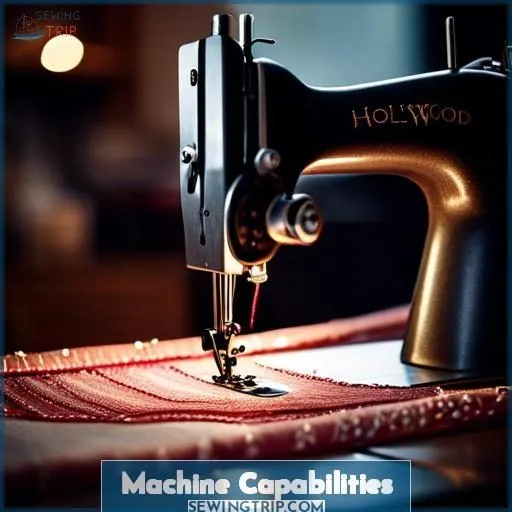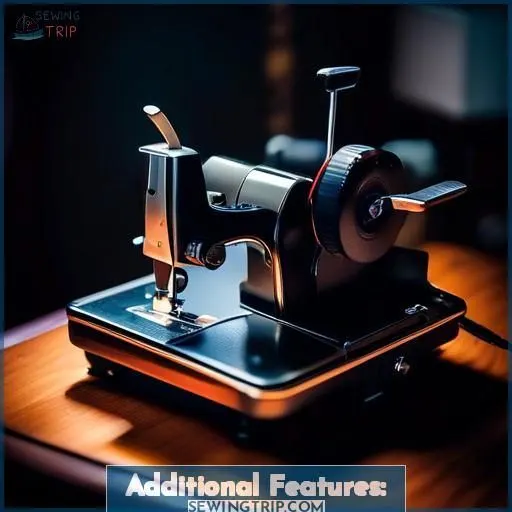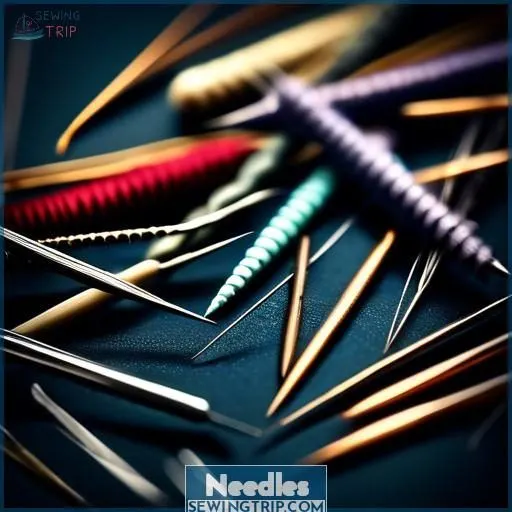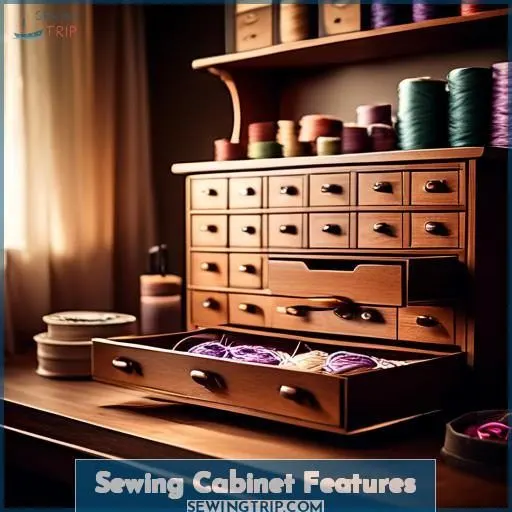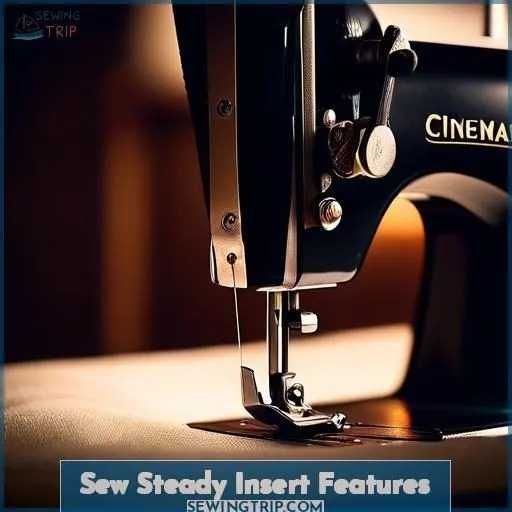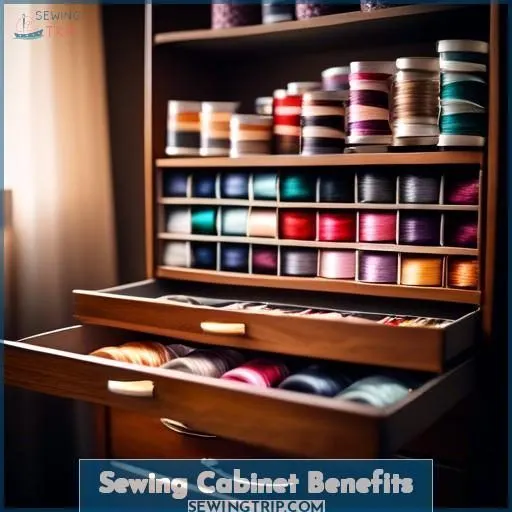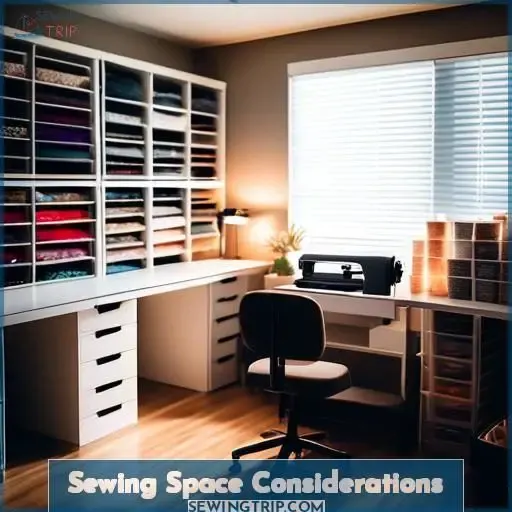This site is supported by our readers. We may earn a commission, at no cost to you, if you purchase through links.
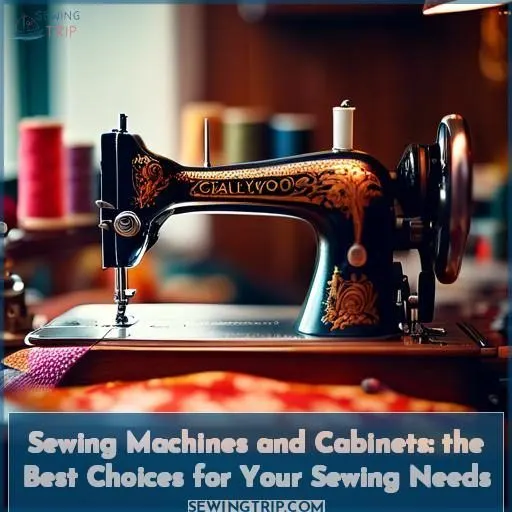
When seeking the best sewing machines and cabinets, you’ll want to prioritize durable construction and reliable capabilities.
Look for machines that handle over 1000 stitches per minute across various fabrics, with essential stitches like straight, zigzag, and buttonholes.
Opt for cabinets with drop-down leaves, ample storage, and mobility.
Guarantee access to local repair services and troubleshooting support.
An ergonomic sewing space with proper lighting and organization is key.
By considering these factors, you’ll discover which sewing machines and cabinets align perfectly with your needs – and open up a world of effortless crafting potential.
Table Of Contents
Key Takeaways
- Prioritize durable construction and reliable capabilities when choosing sewing machines and cabinets.
- Look for machines that can handle over 1,000 stitches per minute across various fabrics, with essential stitches like straight, zigzag, and buttonholes.
- Opt for cabinets with drop-down leaves, ample storage, and mobility.
- Ensure access to local repair services and troubleshooting support.
Machine Capabilities
Your sewing machines and cabinets are the cornerstone of your sewing area, and their competencies are essential to your sewing requirements. Choose machines with durable metal parts capable of managing more than 1000 stitches per minute and handling various fabrics.
Establish the accessibility of repair services for your machines and cabinets.
With the appropriate capabilities, your sewing space can transform into a sanctuary for creativity and innovation, empowering you to undertake any sewing project effortlessly.
Troubleshooting and Support
Regarding sewing machines, even the most dependable models may face difficulties. To guarantee a seamless sewing experience, it’s crucial to be prepared for potential issues and have a plan for resolving them. Here are some troubleshooting and support tips:
- Investigate before purchasing: Before acquiring a sewing machine, investigate the model’s reputation and prevalent issues. This can assist you in avoiding machines with known problems and making an informed choice.
- Confirm local repair services: Inquire if professional sewing machine repair services are available in your vicinity. Having a reliable repair shop nearby can save time and inconvenience when dealing with problems.
- Contemplate service options in various locations: If you travel often or relocate, it’s advisable to select a sewing machine brand with a vast network of service centers. This ensures that you can receive assistance regardless of your location.
- Avoid panic: Don’t wait until a problem arises to consider support. Plan ahead and have a list of nearby repair services or online resources ready for when you need them.
- Guarantee access to assistance: Ensure you have the essential tools and knowledge to troubleshoot typical issues independently. This can help you resolve minor problems promptly and prevent them from developing into major issues.
Essential Stitches
As you explore the realm of sewing, you’ll quickly discern that stitches are the cornerstone of your creations. From the fundamental straight stitch to the adaptable zigzag, each stitch variation has its function. Modifications to these stitches can elevate a simple garment into a masterpiece.
Vital stitches such as buttonholes and overcast stitches are indispensable for diverse applications, while delicate fabrics and knits may necessitate extended zigzag options.
The presser foot and fabric are pivotal in determining which sewing machine aligns with your requirements. Specialized sewing inserts can augment your sewing experience, guaranteeing a smooth work surface and enhancing visibility for increased efficiency.
Additional Features
Additional features of your sewing machine can enhance your sewing experience. Here are three key features to contemplate:
- Needle threaders: Some machines come with built-in needle threaders, which can save time and frustration.
- Automatic thread cutters: These can be convenient, but they may not always cut the thread to the right length. Contemplate manual thread cutters for more control.
- Speed adjusters: While they can be useful, they may hinder the move from home to industrial machines. Look for machines with a range of speeds to suit different fabrics and projects.
Other features to contemplate include an invisible zipper foot, overcast stitch foot, and ample storage space in your sewing cabinet.
Needles
Regarding needles, there’s much to ponder.
Firstly, familiarize yourself with needle types: general for home machines, spherical for knits, and sizes such as 80/12, 90/14, 75/11, 100/16.
Regularly replace needles and purchase in quantity from websites supplying sewing materials.
Disposing of needles is essential, so consider a sewing cabinet with adequate storage.
For garment sewing, focus on essential stitches like straight, zigzag, and buttonhole.
Needle threaders can be exasperating, so seek machines with automatic thread cutters.
And keep in mind, a suitable sewing space can make a significant difference.
Whether it’s a compact studio, kitchen counter, or basement, the appropriate sewing space can elevate your sewing experience.
Sewing Cabinet Features
When selecting a sewing cabinet, you’ll want to verify it possesses attributes that elevate your workflow and sewing experience. Seek out robust construction with wheels for effortless mobility, a drop-down folding leaf that extends your workspace, and adequate storage drawers to maintain the organization of your fabrics, threads, and notions.
such as fabrics
When selecting a sewing cabinet, consider the materials and fabrics that will be used in your projects.
Look for a cabinet with ample storage space for your sewing essentials, such as needles, threads, and patterns.
A kitchen island or communal dining room table can serve as a temporary sewing surface if you don’t have a dedicated sewing space.
For a dorm room, a sewing cabinet with wheels can be easily moved and stored away when not in use.
Remember to choose a cabinet that can accommodate your sewing machine and any additional features you may need, such as an automatic thread cutter or a speed adjuster.
threads
Regarding threads, give thought to the type you’ll be employing.
Cotton threads are perfect for most fabrics, while polyester threads are appropriate for heavier materials.
Thread tension is critical for maintaining a seamless sewing process.
Seek out thread storage options within your sewing cabinet, such as drawers or compartments, to keep your threads organized and readily accessible.
Select a variety of thread colors to complement various fabric types and projects.
Choose high-quality threads for longevity and ease of use.
drawers
Drawers are an essential element of sewing cabinets. They offer ample storage room for your sewing supplies, ensuring everything is within reach.
Consider drawers with adjustable drawer depth, allowing you to personalize the storage space according to your requirements.
A well-crafted drawer system can help you stay organized, making your sewing experience more efficient.
Consider drawers with a lining material that prevents fabric from snagging or fraying.
Additionally, make sure the drawers are sturdy and can withstand the weight of your supplies.
Sew Steady Insert Features
For a superior sewing journey, contemplate investing in a Sew Steady insert – these tailor-made, transparent inserts integrate effortlessly with your sewing cabinet, augmenting clarity and expediting bobbin replacements. By establishing a unified workspace, you’ll relish improved productivity and diminished fabric manipulation, affording you the freedom to concentrate on your innovative vision.
ensuring a seamless work area
To guarantee a smooth work area, consider Sew Steady inserts. These inserts provide a customized fit for your sewing machine, ensuring stability and accuracy. They also offer front-loading bobbin visibility, making thread changes swift and effortless. Additionally, they allow for easy bobbin changes, saving time and effort. With these features, your sewing experience becomes more efficient and enjoyable.
enhancing visibility
Enhance your sewing experience with the Sew Steady Insert, designed to provide clear bobbin visibility and quick, easy bobbin changes. Customize your insert for a perfect fit and enjoy the convenience of front-loading bobbins. Say goodbye to frustrating bobbin issues and hello to seamless sewing.
improving sewing efficiency
Enhance your sewing productivity with Sew Steady inserts. These features guarantee a streamlined work surface and improve clarity. Here’s how they can assist:
- Bobbin winding: Automated bobbins alleviate time and exertion.
- Thread tension: Modifiable thread tension aids in preserving uniformity.
- Fabric storage: Integrated storage maintains fabrics within reach.
- Needle lubrication: Routine lubrication maintains needles operating flawlessly.
- Bobbin visibility: Bobbins loaded from the front facilitate swift and effortless bobbin replacements.
Sewing Cabinet Benefits
When selecting a sewing cabinet, prioritize features that enhance your machine’s capabilities and streamline your workflow. A well-designed cabinet with adjustable workspace, ample storage, and sturdy construction will protect your investment while boosting efficiency and productivity.
Machine Capabilities
Embrace the potency and resilience of your sewing machine. With robust metal components, it can effortlessly handle over 1000 stitches per minute, rendering it a versatile tool suitable for diverse fabrics. Prior to acquisition, investigate machine functionalities to guarantee the provision of repair services and contemplate service options in multiple locales. Avert distress by meticulously planning and securing access to assistance.
Troubleshooting and Support
Regarding troubleshooting and support for your sewing machine, several key aspects are essential to keep in mind. First, you should investigate the accessibility of local repair services, as they can be invaluable when encountering problems that demand on-site attention. It’s also prudent to contemplate service choices in different locations, guaranteeing access to assistance wherever you might be.
To avert anxiety and foster a seamless sewing experience, plan ahead by comprehending your machine’s upkeep schedule and warranty coverage. This includes understanding when to replace needles and how frequently to lubricate your machine. Furthermore, become acquainted with the warranty terms of your sewing machine brand, as this can guide you in navigating any potential repair expenses.
In the event of a malfunction, it’s vital to have access to assistance. This could involve having the contact information for a repair service at hand or being part of a sewing community where you can seek advice from skilled sewers. By being proactive and well-informed, you can reduce downtime and return to your sewing projects as swiftly as possible.
Sewing Cabinet Features
Sewing cabinets are designed to provide a seamless workspace for your sewing machine. Here are three key features to look for:
- Storage space: Ample room for your sewing tools and fabrics is essential.
- Drawer options: Drawers help keep your workspace organized and uncluttered.
- Cabinet materials and work surface: Choose materials that are sturdy and easy to clean, like MDF or laminate. A drop-down folding leaf or adjustable work surface can also enhance your sewing experience.
Sewing Space Considerations
Your sewing space should cater to both creativity and workflow efficiency. While a designated studio isn’t mandatory, strategically positioning your machine, tools, and materials within your available area can noticeably enhance the sewing process.
Sewing Space Layout
Establishing a practical and convenient sewing space is essential for efficient sewing and minimizing discomfort. Here are some tips for organizing your sewing space:
- Ergonomic setup: Make sure your chair can be adjusted and supports your back well. Your feet should rest flat on the floor, and you may need a footrest if your chair doesn’t allow for this. Adjust the chair’s height and angle to maintain an upright sitting position.
- Lighting: Adequate lighting is indispensable for sewing. Install bright, adjustable lighting that illuminates the needle area without causing eye strain. Natural light is ideal, but if it’s not available, use artificial lighting.
- Organization strategies: Keep your fabrics organized using storage solutions such as cinder blocks and wood planks, small plastic drawers, transparent bins, or hanging fabric from cinder blocks. Store fabric scraps in mason jars, buckets, or wire bins. Use shoe organizers, shoe boxes, or plastic tubs for larger fabric collections.
- Space constraints: Maximize your space by using vertical storage solutions such as magazine racks, hanging fabric storage, or wire shelving. Consider repurposing an old crib or hutch for additional storage.
- Fabric storage: Sort fabric by color, manufacturer, or pattern. Use dividers to separate fabrics within drawers or bins. Keep batting, fusible web, and freezer paper in shoe organizers or plastic tubs.
- Sewing machine placement: Position your sewing machine at a comfortable height and distance. Make sure the table surface is suitable for your workpiece and can be adjusted in height and angle.
- Accessories: Use an ergonomic chair with a cushioned backrest and adjustable height, seat angle, and backrest position. Consider using a swivel chair that meets the DIN 68877 standard.
- Movement: Encourage frequent changes of position and vary your tasks to reduce strain and fatigue. This can help prevent long-term physical damage to your musculoskeletal system.
Machine Capabilities
Concerning machine capabilities, there are a few crucial factors to contemplate.
Firstly, you desire a machine that’s sturdy and can handle a variety of materials.
Seek machines with robust metal parts and over 1000 stitches per minute.
Additionally, investigate the machine to verify that repair services are accessible if necessary.
A reliable sewing machine should have high-quality stitches and be easy to maintain.
Consider the simplicity of threading and bobbin replacements, as well as the machine’s ability to handle varying fabric thicknesses.
By prioritizing these factors, you can locate a sewing machine that will fulfill your requirements and endure for years to come.
Troubleshooting Support
When your sewing machine throws a tantrum, don’t let it unravel your plans. Scout for local repair services before you’re in a stitch. Having service options in multiple locations means you’re never caught threadbare. Planning ahead is your secret weapon against sewing snags. Remember, a stitch in time saves nine, so map out those repair spots like treasure.
Frequently Asked Questions (FAQs)
What is the best sewing machine for beginners?
You can’t go wrong with a basic, sturdy machine. Look for metal interior parts, top-loading bobbin, and user-friendly features like needle threaders and zig-zag stitching capabilities. With proper research, you’ll find an affordable workhorse that’ll let your sewing skills blossom.
How often should I change needles on my sewing machine?
Change needles regularly – every 4-6 hours of sewing or when switching fabrics. Sharp needles glide smoothly, prevent skipped stitches, and extend your machine’s life. Like brushing your teeth daily for oral health, fresh needles keep your stitching pristine.
What is the difference between mechanical and computerized sewing machines?
The key difference? Mechanical machines use gears and cams, while computerized ones have microprocessors for stitch selection, speed control, and customization. Computerized models offer more features but can be pricier. Consider your needs – a high-quality mechanical machine might be all you require.
What should I consider when buying a used sewing machine?
When buying a used sewing machine, be sure to check for smooth operation, test all functions, and negotiate a fair price. Don’t get in over your head – it’s a piece of cake with some savvy shopping.
How can I ensure my sewing machine is in good working condition before use?
Before using your sewing machine, thoroughly inspect it. Check the needle, test stitch quality, and make sure all moving parts operate smoothly. This’ll keep your machine running like a charm and avoid any expensive surprises in the future.
Conclusion
Discovering the key to effortless crafting rests in finding the ideal sewing machines and cabinets customized to your specific requirements. By giving precedence to sturdy construction, dependable functionalities, and key features, you’ll identify the most suitable sewing solutions that enhance your projects and transform your sewing experience.
Embrace the realm of seamless stitching and unfetter your creative potential with the finest sewing machines and cabinets available.

